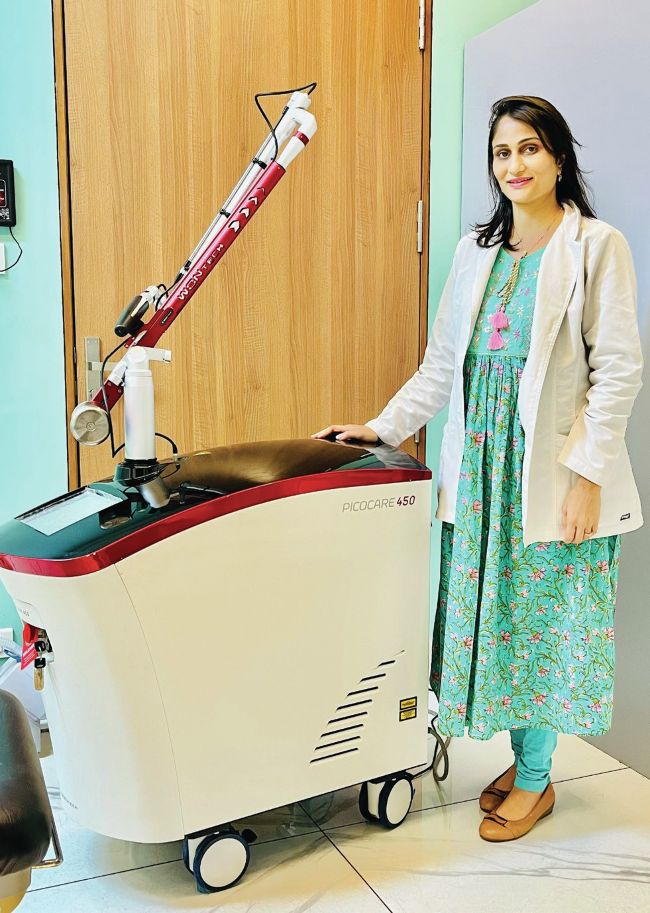SKIN REJUVENATION

Dr Vindhya Pai’s
“Picosecond lasers offer quick and efficient treatment options for skin rejuvenation.”
-Dr Vindhya Pai, Dermatologist & Founder, The Skin Clinic
How do you determine the appropriate treatment parameters for laser therapy for skin rejuvenation?
A comprehensive understanding of the client’s expectations and skin condition is essential to provide safe and effective laser therapy for skin rejuvenation. We evaluate the client’s skin to ensure it is healthy enough for laser therapy for skin rejuvenation. After assessing skin, we customise a treatment plan based on their expectations. We make sure our clients understand that laser therapy is not a one-time solution and that they may need several treatments over a few weeks to achieve the desired results. Additionally, we emphasise the importance of a homecare regimen, especially using sunscreen and moisturiser, which is essential for maintaining healthy skin.
We educate our clients about the potential risks and complications associated with laser treatment, such as burns, scars, and hyperpigmentation, especially for those with darker skin tones. To avoid hyperpigmentation, we use a lower intensity setting for ethnic skin tones. We inform clients that laser treatment stimulates the production of healthier collagen, elastin fibres, and skin, which can take weeks or months to produce visible effects.
Tell us about the key benefits of picosecond lasers for skin rejuvenation.
Picosecond lasers are a great addition to the market for skin rejuvenation, as they offer quick and efficient treatment options. Compared to other laser systems, the laser delivers higher intensity energy on a single spot size, allowing for the treatment of pores, scars, and uneven skin tone in a single treatment. The recovery period is also shorter, at only about 24 hours, making it a popular choice for patients. In our clinic, we have even added the picosecond laser to our bridal package, as it can be used after hydrafacial for skin toning. Overall, I am pleased with the results we have seen using the picosecond laser in conjunction with other treatments.
How do you tailor your laser treatment approach, and what kind of pre-treatment preparation do you recommend, especially while using picosecond lasers?
To ensure effective laser treatment, we first assess the patient’s skin type and concerns. Before the treatment, we ensure that their skin is well hydrated and advise them to follow a simple homecare regimen like using sunscreen and moisturizer. We avoid performing the treatment on dry skin during the first visit and ask them to return after a week. For ethnic skin tones, we use lower energy, while for fair skin, we use high intensity. Most treatments at our clinic consist of three to four sessions, with a gap of three weeks between each session. After completing the sessions, patients can expect around 40 per cent improvement, and we recommend a follow-up after 8-12 weeks for further improvement. Sessions usually last around 10-12 minutes, and patients can return to work immediately after.
However, some areas treated with the high-intensity microlens array (MLA) may cause a rubber band snapping sensation on the face for 24-48 hours. Overall, our laser treatment approach is tailored to the patient’s skin type and concerns, and we recommend pre-treatment preparation for optimal results.
What kind of long-term follow-up do you provide to patients?
I suggest maintenance sessions every 6 to 12 months based on each individual’s skin concerns and condition. I also advise patients to maintain their results by following a good skincare regimen. Sun protection education is also provided, and patients are advised to avoid prolonged sun exposure, which can reverse the effects of the treatment. I believe in a personalised approach to treatment and follow-up, enabling me to tailor the treatment plan to each patient’s specific needs.